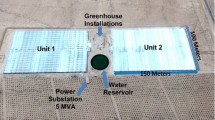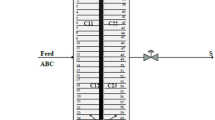Abstract
The traditional tuning scheme of proportional, integral, and derivative (PID) controller parameters usually lay more emphasis on control performances than economic profits. As a result, the corresponding control performance is improved, but such case may lead to high production costs. In this paper, a new tuning methodology for multiple PID controllers from an economic point of view by incorporating multiple performance measures and production costs based on nondominated sorting genetic algorithm-II (NSGA-II) is presented. A model of nonlinear thermodynamic laws between numerous system variables affecting the greenhouse climate is formulated. The proposed tuning scheme is tested through step responses for greenhouse climate control by minimizing the indices of overall performance and production cost in a simulation experiment. The results show that the controllers by tuning the gain parameters can achieve good control performance at a relatively low cost. Maybe it is a quite effective and promising tuning method by using this method in the complex greenhouse production.











Similar content being viewed by others
References
Van Straten G, Van Henten EJ (2010) Optimal greenhouse cultivation control: survey and perspectives. In: Proceedings of the agricontrol, IFAC, 6–8 Dec., Kyoto, Japan
Chen J, Huang Tien-Chih (2004) Applying neural networks to on-line updated PID controllers for nonlinear process control. J Process Control 14:211–230
Wang H, Yuan X, Wang Y, Yang Y (2011) Harmony search algorithm-based fuzzy-PID controller for electronic throttle valve. Neural Comput Appl (in press). doi:10.1007/s00521-011-0678-3
Åström Karl J, Hägglund T (1995) PID Controllers: theory, design, and tuning, 2nd ed. Research Triangle Park, Instrument Society American, NC
Ziegler JG, Nichols NB (1942) Optimum settings for automatic controllers. Trans ASME 64:759–768
Huang YW, Tung PC, Wu CY (2007) Tuning PID control of an automatic arc welding system using a SMAW process. Int J Adv Manuf Technol 34:56–61
Arruda LVR, Swiech MCS, Delgado MRB, Neves-Jr F (2008) PID control of MIMO process based on rank niching genetic algorithm. Appl Intell 29:290–305
Herrero JM, Blasco X, Martínez M, Sanchis J (2008) Multiobjective tuning of robust PID controllers using evolutionary algorithms. EvoWorkshops 2008 LNCS 4974:515–524
Ayala HVH, dos Santos Coelho L (2008) A multiobjective genetic algorithm applied to multivariable control optimization. ABCM Symp Series Mechatron 3:736–745
Deb K, Pratap A, Agarwal S, Meyarivan T (2002) A fast and elitist multiobjective genetic algorithm: Nsga-ii. IEEE Trans Evol Comput 6:182–197
Nielsen B, Madsen H (1998) Identification of a linear continuous time stochastic model of the heat dynamic of a greenhouse. J Agr Eng Res 71:249–256
Tap R F (2000) Economics-based optimal control of greenhouse tomato crop production. Ph.D. Thesis. Wageningen University, Wageningen
Ghosal MK, Tiwari GN, Srivastava NSL (2003) Modeling and experimental validation of a greenhouse with evaporative cooling by moving water film over external shade cloth. Energy Build 35:843–850
Fourati F, Chtourou M (2007) A greenhouse control with feed-forward and recurrent neural networks. Simul Model Pract Theory 15:1016–1028
Trejo-Perea M, Herrera-Ruiz G, Rios-Moreno J, Miranda RC, Rivas-Araiza E (2009) Greenhouse energy consumption prediction using neural networks models. Int J Agric Biol 11:1–6
He F, Ma C (2010) Modeling greenhouse air humidity by means of artificial neural network and principal component analysis. Comput Electron Agric 71:S19–S23
Pasgianos GD, Arvanitis KG, Polycarpou P, Sigrimis N (2003) A nonlinear feedback technique for greenhouse environmental control. Comput Electron Agric 40:153–177
Albright LD, Gates RS, Arvanitis KG, Drysdale AE (2001) Environmental control for plants on earth and in space. IEEE control system magazine. pp 28–47
Hu HG, Xu LH, Wei RH, Zhu BK (2010) Multi-objective tuning of nonlinear PID controllers for greenhouse environment using evolutionary algorithms. 2010 IEEE congress on evolutionary computation (IEEE CEC 2010), July 18–23, 2010. Barcelona, Spain
Hu HG, Xu LH, Wei RH, Zhu BK (2011) Multi-objective control optimization for greenhouse environment using evolutionary algorithms. Sensors 11(5):5792–5807
Gaing ZL (2004) A particle swarm optimization approach for optimum design of PID controller in AVR system. IEEE Trans Energy Convers 19(2):384–391
Loghmanian SMR, Jamaluddin H, Ahmad R, et al (2011) Structure optimization of neural network for dynamic system modeling using multi-objective genetic algorithm. Neural Comput Appl (in press). doi:10.1007/s00521-011-0560-3
Sheikhan M, Shahnazi R, Hemmati E (2012) Adaptive active queue management controller for TCP communication networks using PSO-RBF models. Neural Comput Appl (in press). doi:10.1007/s00521-011-0786-0
Acknowledgments
The authors would like to express their appreciation to the referees for their helpful comments and suggestions. This work was supported by the key task of high-tech in 863 project for the 12th five-year plan (Grant No. 2012AA10A507), the National Natural Science Foundations of China (Grant No. 61174090, 61174023, 60903144, and 61272313). And supported by Natural Science Foundation (Grant No. Y1110880), Science and Technology Planning Project (Grant No. 2012C21015) and Forestry Department (Grant No. 2010B13) of Zhejiang Province of China, and also supported by BEACON (An NSF Science and Technology Center for the Study of Evolution in Action, Coop. Agmt.) of USA under the Grant No. DBI-0939454.
Author information
Authors and Affiliations
Corresponding author
Rights and permissions
About this article
Cite this article
Hu, H., Xu, L., Goodman, E.D. et al. NSGA-II-based nonlinear PID controller tuning of greenhouse climate for reducing costs and improving performances. Neural Comput & Applic 24, 927–936 (2014). https://doi.org/10.1007/s00521-012-1312-8
Received:
Accepted:
Published:
Issue Date:
DOI: https://doi.org/10.1007/s00521-012-1312-8




